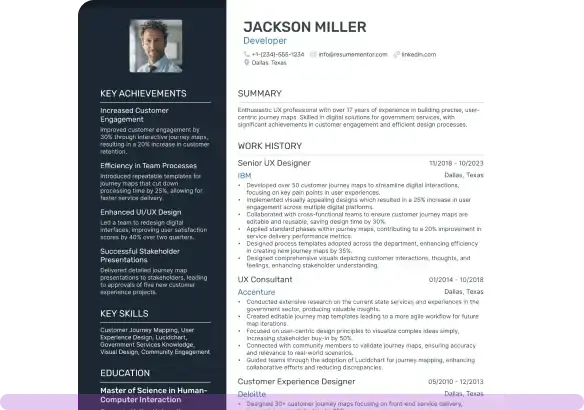Quality Control Resume Examples

Mar 26, 2025
|
12 min read
Crafting a quality control resume is no small feat—ensure yours is in tip-top shape. Discover how to highlight your attention to detail and problem-solving skills. Be the one who stands out, not just a 'fault' finder!
Rated by 348 people
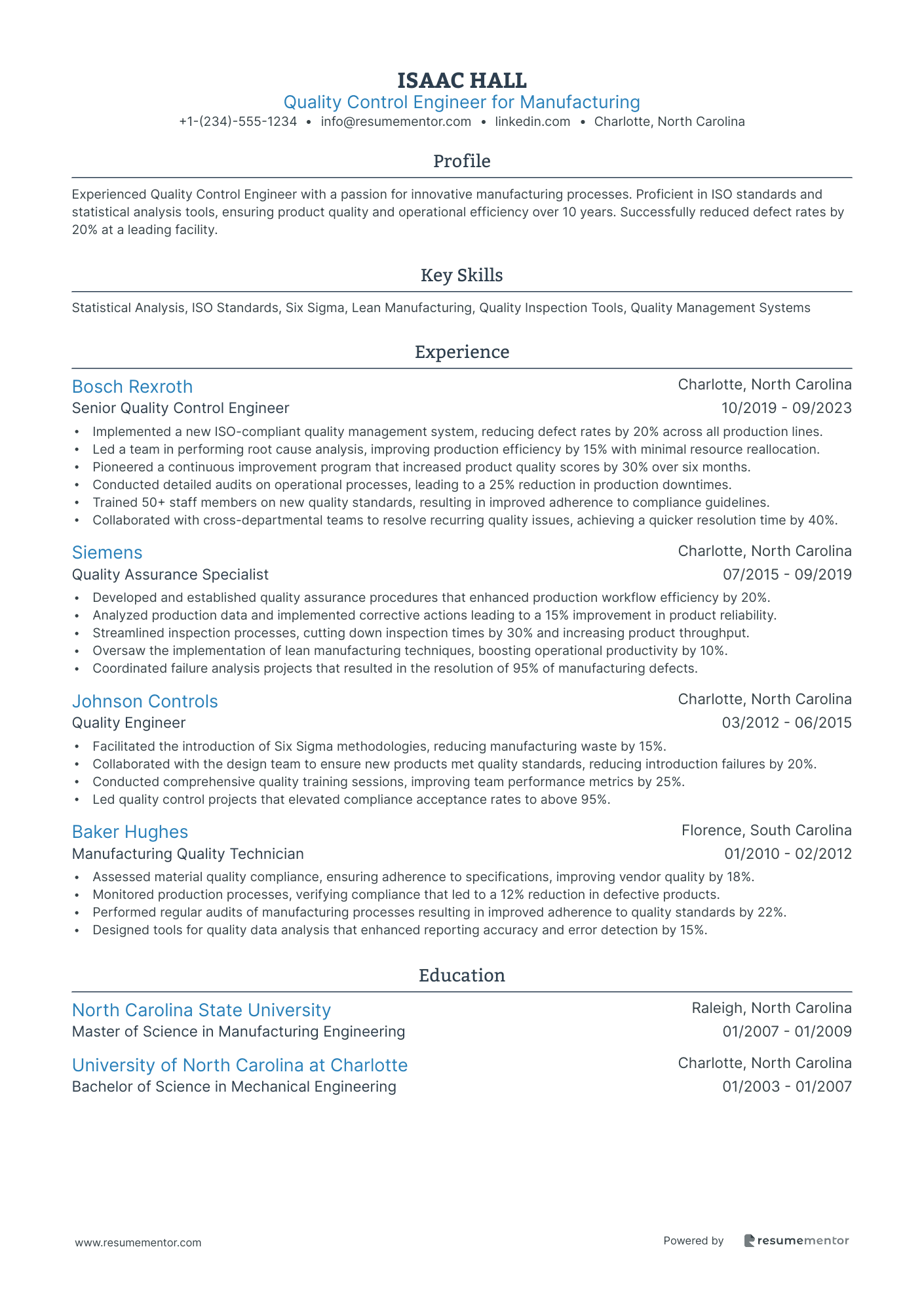
Quality Control Engineer for Manufacturing

Pharmaceutical Quality Assurance Specialist
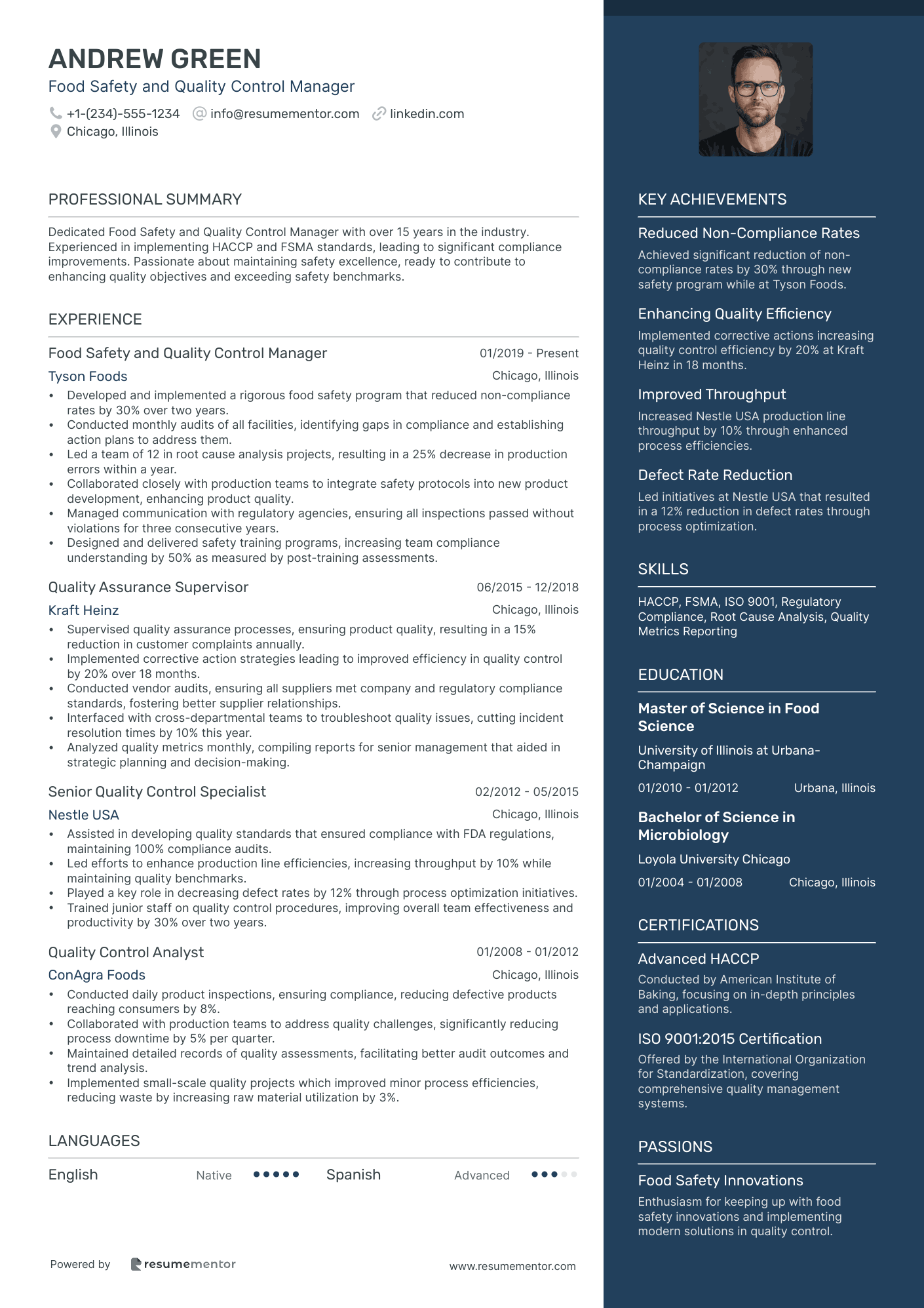
Food Safety and Quality Control Manager
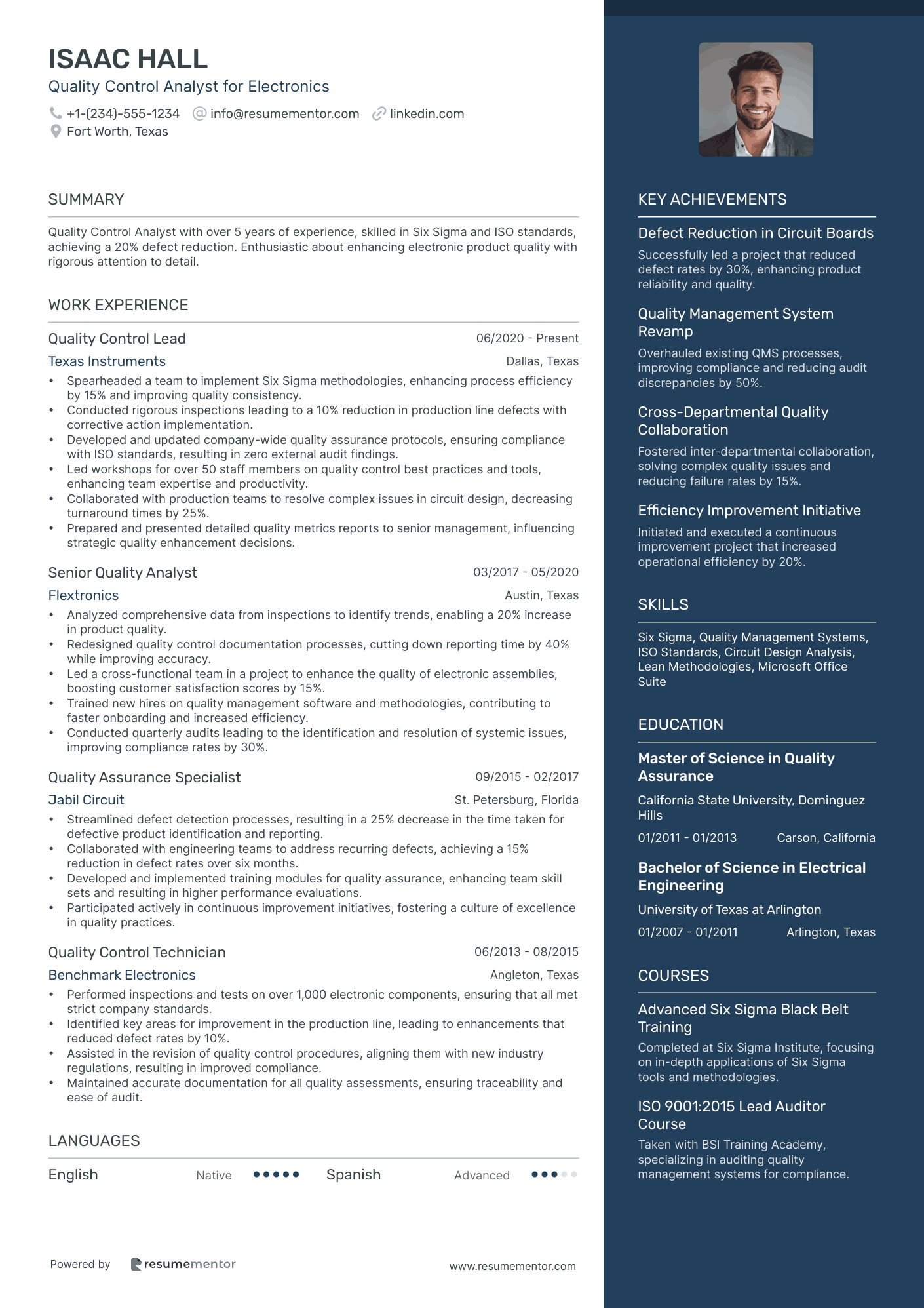
Quality Control Analyst for Electronics
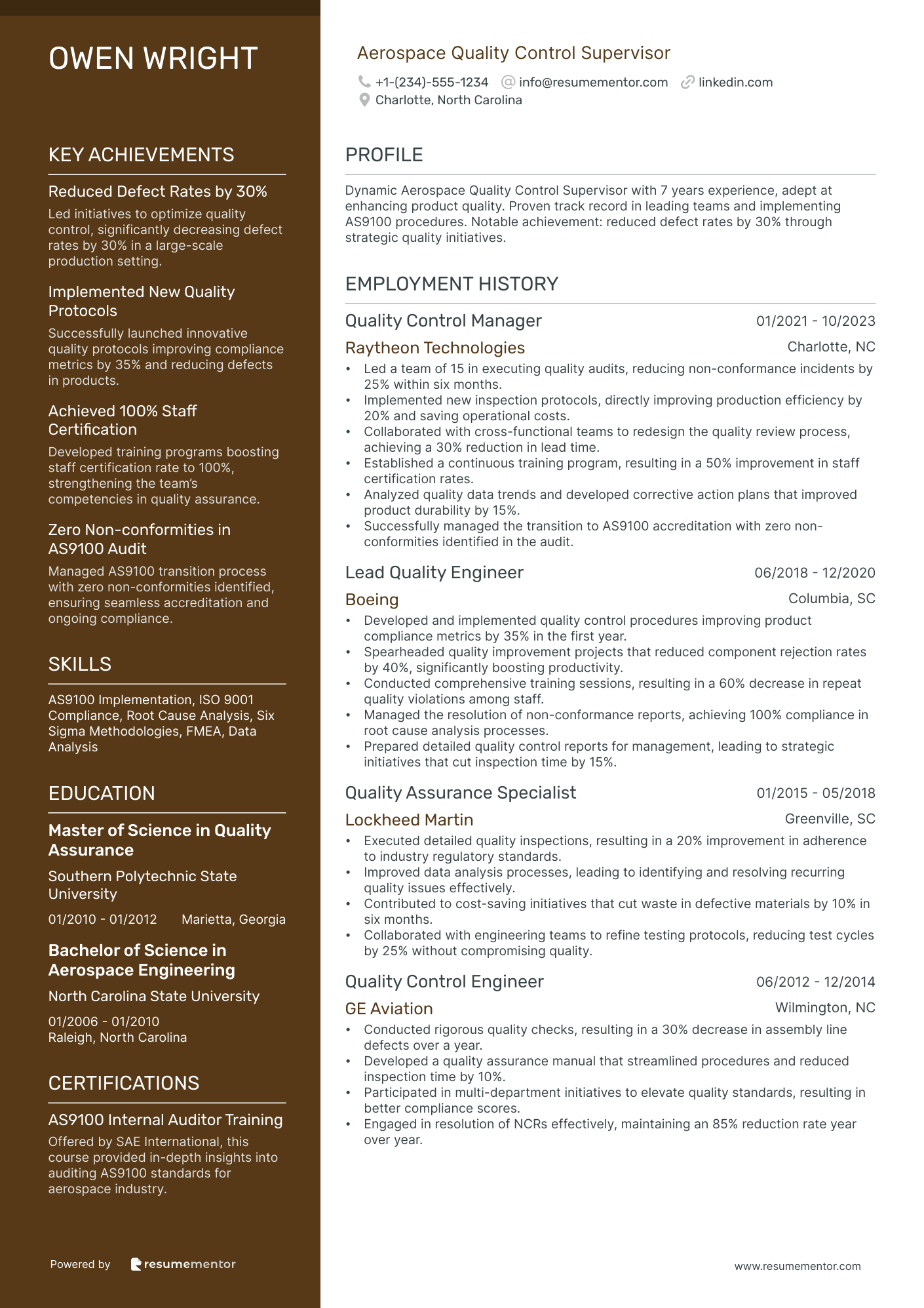
Aerospace Quality Control Supervisor
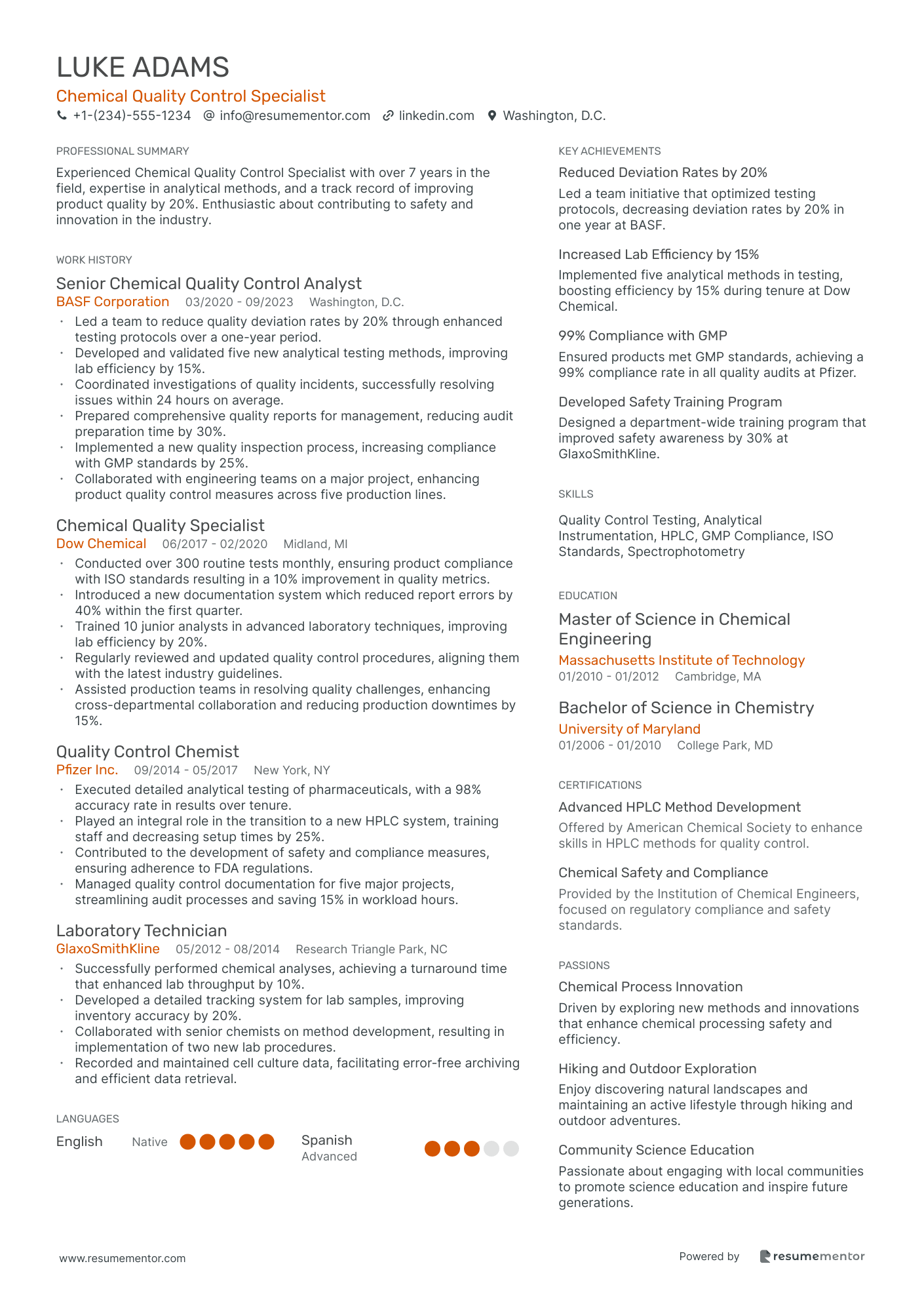
Chemical Quality Control Specialist
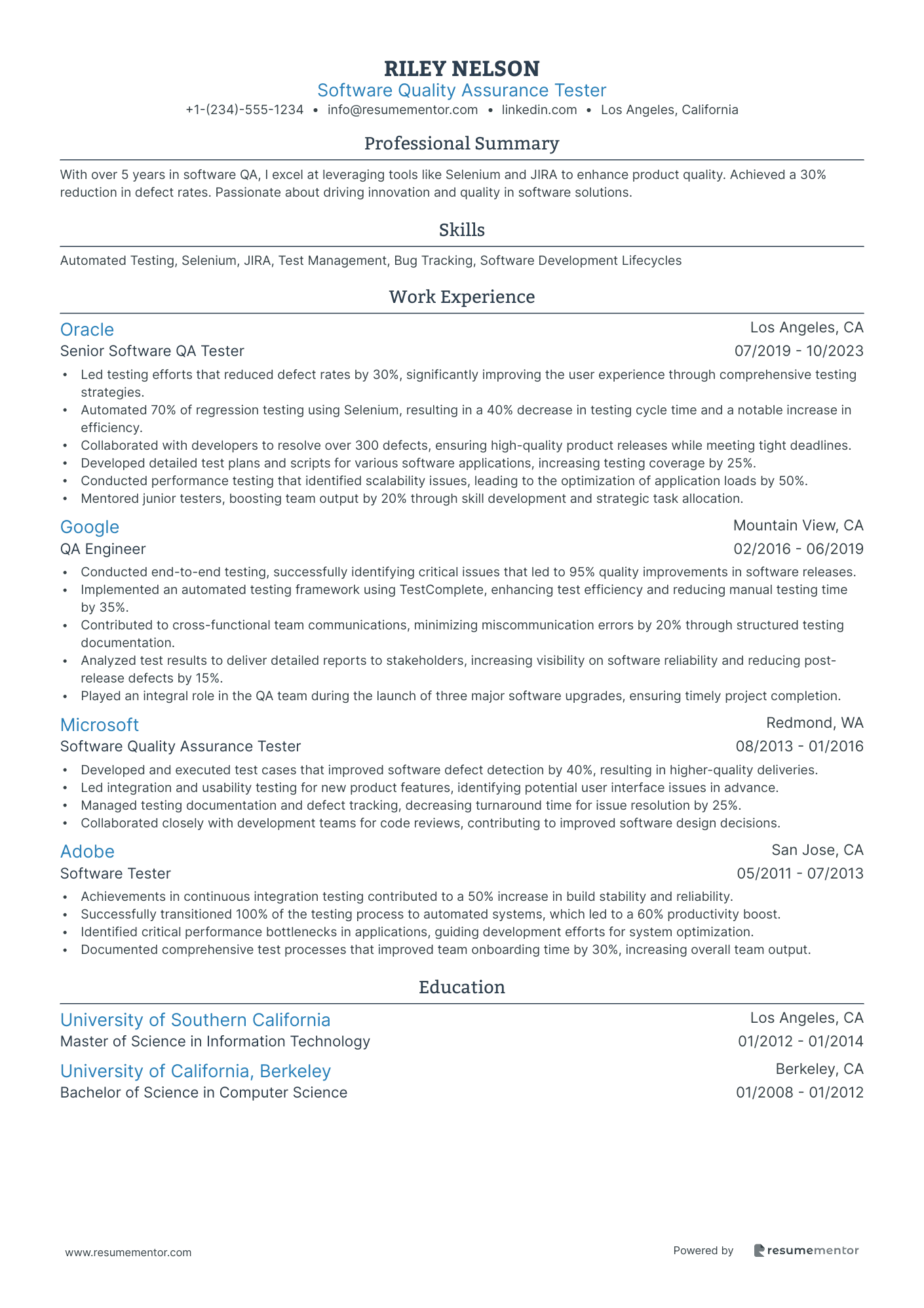
Software Quality Assurance Tester
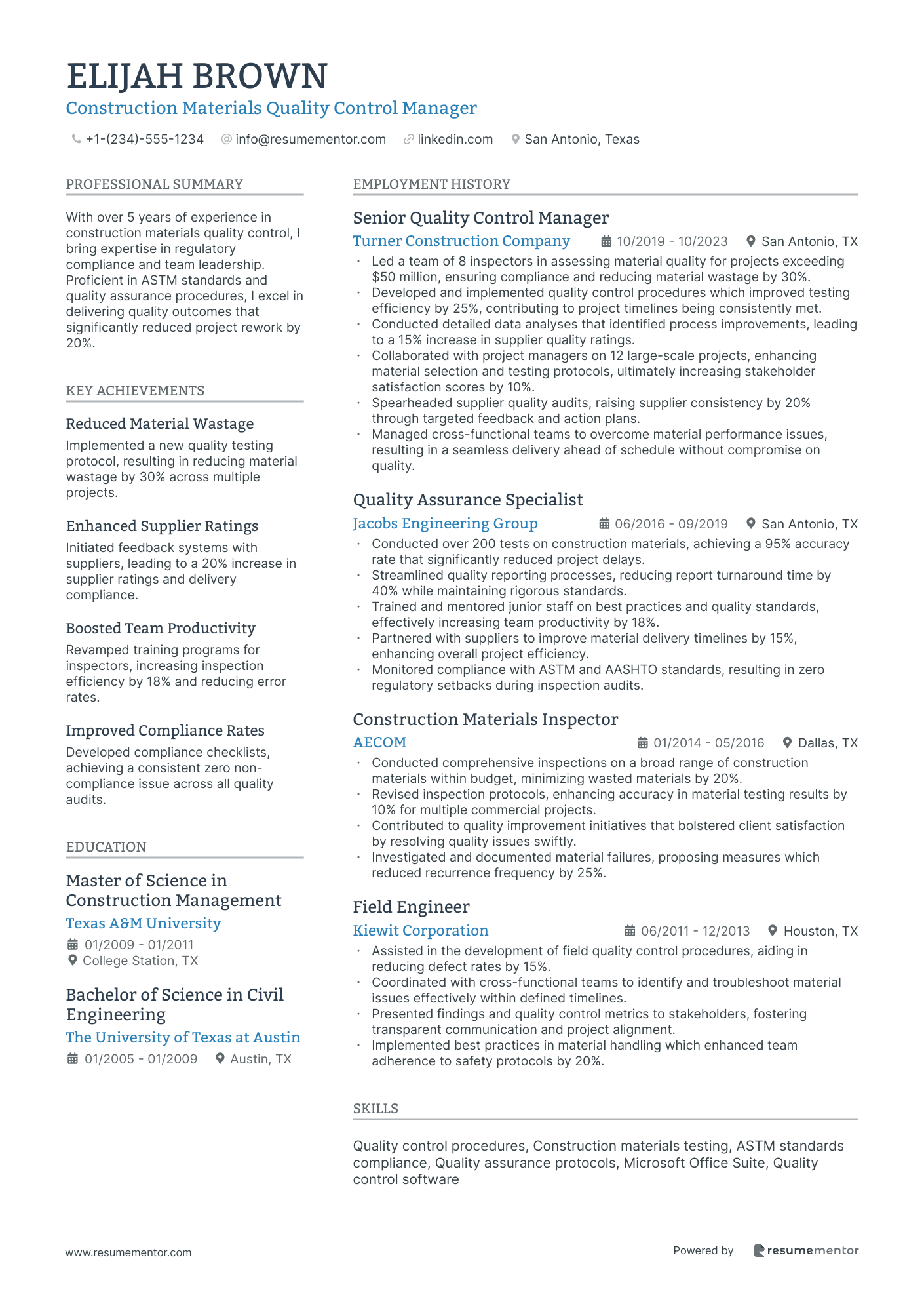
Construction Materials Quality Control Manager
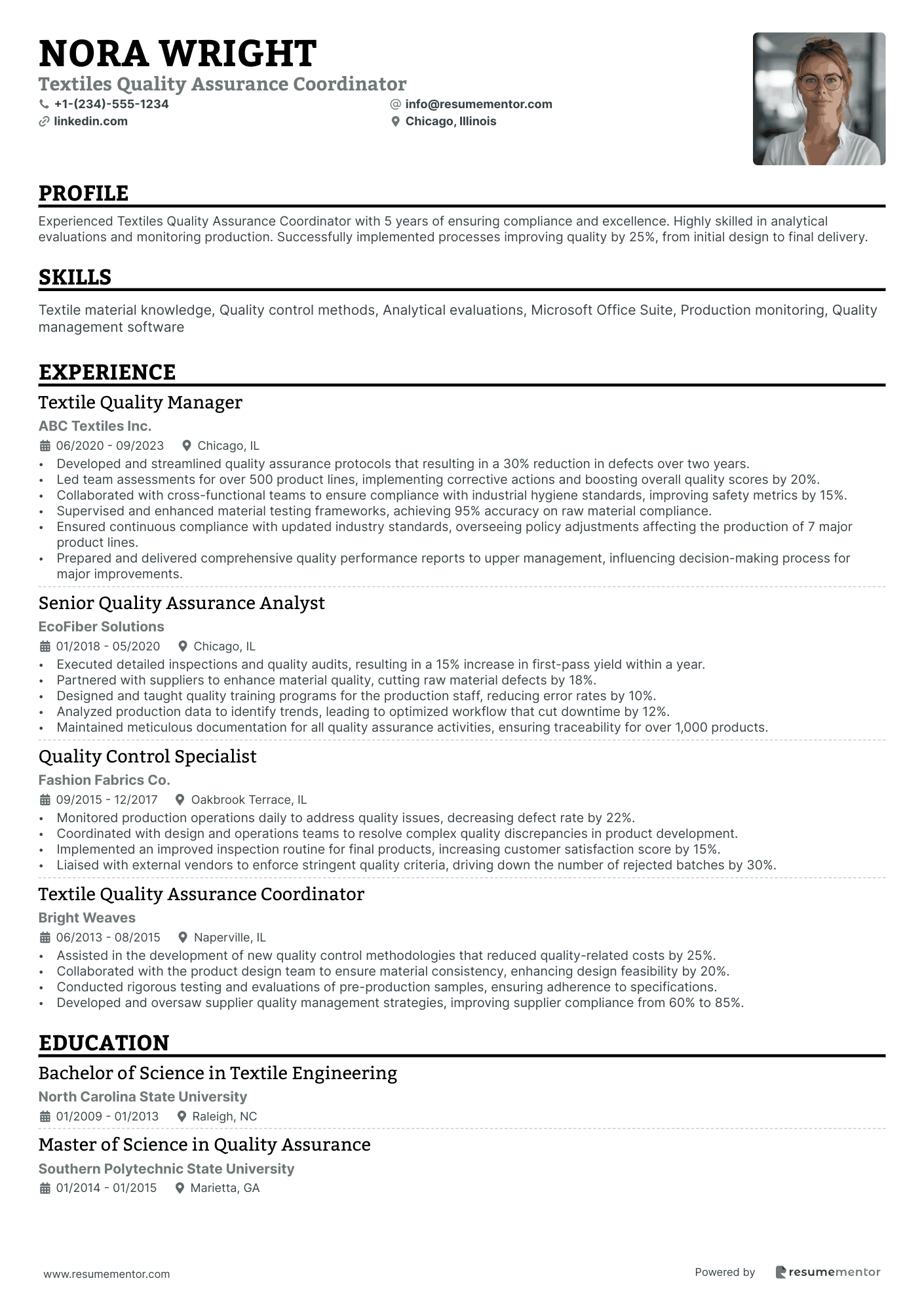
Textiles Quality Assurance Coordinator

Quality Control Engineer for Manufacturing resume sample
- •Implemented a new ISO-compliant quality management system, reducing defect rates by 20% across all production lines.
- •Led a team in performing root cause analysis, improving production efficiency by 15% with minimal resource reallocation.
- •Pioneered a continuous improvement program that increased product quality scores by 30% over six months.
- •Conducted detailed audits on operational processes, leading to a 25% reduction in production downtimes.
- •Trained 50+ staff members on new quality standards, resulting in improved adherence to compliance guidelines.
- •Collaborated with cross-departmental teams to resolve recurring quality issues, achieving a quicker resolution time by 40%.
- •Developed and established quality assurance procedures that enhanced production workflow efficiency by 20%.
- •Analyzed production data and implemented corrective actions leading to a 15% improvement in product reliability.
- •Streamlined inspection processes, cutting down inspection times by 30% and increasing product throughput.
- •Oversaw the implementation of lean manufacturing techniques, boosting operational productivity by 10%.
- •Coordinated failure analysis projects that resulted in the resolution of 95% of manufacturing defects.
- •Facilitated the introduction of Six Sigma methodologies, reducing manufacturing waste by 15%.
- •Collaborated with the design team to ensure new products met quality standards, reducing introduction failures by 20%.
- •Conducted comprehensive quality training sessions, improving team performance metrics by 25%.
- •Led quality control projects that elevated compliance acceptance rates to above 95%.
- •Assessed material quality compliance, ensuring adherence to specifications, improving vendor quality by 18%.
- •Monitored production processes, verifying compliance that led to a 12% reduction in defective products.
- •Performed regular audits of manufacturing processes resulting in improved adherence to quality standards by 22%.
- •Designed tools for quality data analysis that enhanced reporting accuracy and error detection by 15%.
Pharmaceutical Quality Assurance Specialist resume sample
- •Led cross-functional teams to enhance quality controls, resulting in a 25% improvement in compliance audit scores.
- •Conducted comprehensive audits in manufacturing facilities, identifying 15 areas for improvement and reducing errors by 40%.
- •Streamlined document review process, reducing turnaround time by 35% and increasing operational efficiency across the board.
- •Developed employee training modules for FDA regulations, improving staff compliance understanding by 28%.
- •Implemented corrective action plans for quality deviations, achieving a reduction in incidents by 30% annually.
- •Collaborated with regulatory affairs, successfully achieving a full compliance status during the 2022 FDA audit.
- •Supervised the QA team in conducting process audits, achieving 98% compliance with GMP requirements.
- •Enhanced quality assurance programs, leading to a 20% increase in product release speed and efficiency.
- •Facilitated a cross-departmental project to develop new SOPs, decreasing production non-conformances by 18%.
- •Reviewed and approved over 500 batch records ensuring 100% accuracy and quality compliance.
- •Provided expert guidance on quality control, contributing to a 15% improvement in test result validation times.
- •Performed routine testing and validation of pharmaceutical compounds with a 99% accuracy rate.
- •Assisted in a risk management project, resulting in a 22% decrease in quality-related recalls.
- •Supported manufacturing teams, enhancing collaborative efforts that increased process efficiency by 15%.
- •Participated in developing quality metrics dashboard, improving data transparency and decision-making speed.
- •Coordinated internal audits, achieving a high compliance rate of 95% among production lines.
- •Implemented a monthly review cycle of SOPs, leading to a 20% reduction in document discrepancies.
- •Launched an initiative for corrective action tracking, enhancing resolution times by 30%.
- •Conducted training sessions on quality assurance methods, improving team understanding and efficiency.
Food Safety and Quality Control Manager resume sample
- •Developed and implemented a rigorous food safety program that reduced non-compliance rates by 30% over two years.
- •Conducted monthly audits of all facilities, identifying gaps in compliance and establishing action plans to address them.
- •Led a team of 12 in root cause analysis projects, resulting in a 25% decrease in production errors within a year.
- •Collaborated closely with production teams to integrate safety protocols into new product development, enhancing product quality.
- •Managed communication with regulatory agencies, ensuring all inspections passed without violations for three consecutive years.
- •Designed and delivered safety training programs, increasing team compliance understanding by 50% as measured by post-training assessments.
- •Supervised quality assurance processes, ensuring product quality, resulting in a 15% reduction in customer complaints annually.
- •Implemented corrective action strategies leading to improved efficiency in quality control by 20% over 18 months.
- •Conducted vendor audits, ensuring all suppliers met company and regulatory compliance standards, fostering better supplier relationships.
- •Interfaced with cross-departmental teams to troubleshoot quality issues, cutting incident resolution times by 10% this year.
- •Analyzed quality metrics monthly, compiling reports for senior management that aided in strategic planning and decision-making.
- •Assisted in developing quality standards that ensured compliance with FDA regulations, maintaining 100% compliance audits.
- •Led efforts to enhance production line efficiencies, increasing throughput by 10% while maintaining quality benchmarks.
- •Played a key role in decreasing defect rates by 12% through process optimization initiatives.
- •Trained junior staff on quality control procedures, improving overall team effectiveness and productivity by 30% over two years.
- •Conducted daily product inspections, ensuring compliance, reducing defective products reaching consumers by 8%.
- •Collaborated with production teams to address quality challenges, significantly reducing process downtime by 5% per quarter.
- •Maintained detailed records of quality assessments, facilitating better audit outcomes and trend analysis.
- •Implemented small-scale quality projects which improved minor process efficiencies, reducing waste by increasing raw material utilization by 3%.
Quality Control Analyst for Electronics resume sample
- •Spearheaded a team to implement Six Sigma methodologies, enhancing process efficiency by 15% and improving quality consistency.
- •Conducted rigorous inspections leading to a 10% reduction in production line defects with corrective action implementation.
- •Developed and updated company-wide quality assurance protocols, ensuring compliance with ISO standards, resulting in zero external audit findings.
- •Led workshops for over 50 staff members on quality control best practices and tools, enhancing team expertise and productivity.
- •Collaborated with production teams to resolve complex issues in circuit design, decreasing turnaround times by 25%.
- •Prepared and presented detailed quality metrics reports to senior management, influencing strategic quality enhancement decisions.
- •Analyzed comprehensive data from inspections to identify trends, enabling a 20% increase in product quality.
- •Redesigned quality control documentation processes, cutting down reporting time by 40% while improving accuracy.
- •Led a cross-functional team in a project to enhance the quality of electronic assemblies, boosting customer satisfaction scores by 15%.
- •Trained new hires on quality management software and methodologies, contributing to faster onboarding and increased efficiency.
- •Conducted quarterly audits leading to the identification and resolution of systemic issues, improving compliance rates by 30%.
- •Streamlined defect detection processes, resulting in a 25% decrease in the time taken for defective product identification and reporting.
- •Collaborated with engineering teams to address recurring defects, achieving a 15% reduction in defect rates over six months.
- •Developed and implemented training modules for quality assurance, enhancing team skill sets and resulting in higher performance evaluations.
- •Participated actively in continuous improvement initiatives, fostering a culture of excellence in quality practices.
- •Performed inspections and tests on over 1,000 electronic components, ensuring that all met strict company standards.
- •Identified key areas for improvement in the production line, leading to enhancements that reduced defect rates by 10%.
- •Assisted in the revision of quality control procedures, aligning them with new industry regulations, resulting in improved compliance.
- •Maintained accurate documentation for all quality assessments, ensuring traceability and ease of audit.
Aerospace Quality Control Supervisor resume sample
- •Led a team of 15 in executing quality audits, reducing non-conformance incidents by 25% within six months.
- •Implemented new inspection protocols, directly improving production efficiency by 20% and saving operational costs.
- •Collaborated with cross-functional teams to redesign the quality review process, achieving a 30% reduction in lead time.
- •Established a continuous training program, resulting in a 50% improvement in staff certification rates.
- •Analyzed quality data trends and developed corrective action plans that improved product durability by 15%.
- •Successfully managed the transition to AS9100 accreditation with zero non-conformities identified in the audit.
- •Developed and implemented quality control procedures improving product compliance metrics by 35% in the first year.
- •Spearheaded quality improvement projects that reduced component rejection rates by 40%, significantly boosting productivity.
- •Conducted comprehensive training sessions, resulting in a 60% decrease in repeat quality violations among staff.
- •Managed the resolution of non-conformance reports, achieving 100% compliance in root cause analysis processes.
- •Prepared detailed quality control reports for management, leading to strategic initiatives that cut inspection time by 15%.
- •Executed detailed quality inspections, resulting in a 20% improvement in adherence to industry regulatory standards.
- •Improved data analysis processes, leading to identifying and resolving recurring quality issues effectively.
- •Contributed to cost-saving initiatives that cut waste in defective materials by 10% in six months.
- •Collaborated with engineering teams to refine testing protocols, reducing test cycles by 25% without compromising quality.
- •Conducted rigorous quality checks, resulting in a 30% decrease in assembly line defects over a year.
- •Developed a quality assurance manual that streamlined procedures and reduced inspection time by 10%.
- •Participated in multi-department initiatives to elevate quality standards, resulting in better compliance scores.
- •Engaged in resolution of NCRs effectively, maintaining an 85% reduction rate year over year.
Chemical Quality Control Specialist resume sample
- •Led a team to reduce quality deviation rates by 20% through enhanced testing protocols over a one-year period.
- •Developed and validated five new analytical testing methods, improving lab efficiency by 15%.
- •Coordinated investigations of quality incidents, successfully resolving issues within 24 hours on average.
- •Prepared comprehensive quality reports for management, reducing audit preparation time by 30%.
- •Implemented a new quality inspection process, increasing compliance with GMP standards by 25%.
- •Collaborated with engineering teams on a major project, enhancing product quality control measures across five production lines.
- •Conducted over 300 routine tests monthly, ensuring product compliance with ISO standards resulting in a 10% improvement in quality metrics.
- •Introduced a new documentation system which reduced report errors by 40% within the first quarter.
- •Trained 10 junior analysts in advanced laboratory techniques, improving lab efficiency by 20%.
- •Regularly reviewed and updated quality control procedures, aligning them with the latest industry guidelines.
- •Assisted production teams in resolving quality challenges, enhancing cross-departmental collaboration and reducing production downtimes by 15%.
- •Executed detailed analytical testing of pharmaceuticals, with a 98% accuracy rate in results over tenure.
- •Played an integral role in the transition to a new HPLC system, training staff and decreasing setup times by 25%.
- •Contributed to the development of safety and compliance measures, ensuring adherence to FDA regulations.
- •Managed quality control documentation for five major projects, streamlining audit processes and saving 15% in workload hours.
- •Successfully performed chemical analyses, achieving a turnaround time that enhanced lab throughput by 10%.
- •Developed a detailed tracking system for lab samples, improving inventory accuracy by 20%.
- •Collaborated with senior chemists on method development, resulting in implementation of two new lab procedures.
- •Recorded and maintained cell culture data, facilitating error-free archiving and efficient data retrieval.
Software Quality Assurance Tester resume sample
- •Led testing efforts that reduced defect rates by 30%, significantly improving the user experience through comprehensive testing strategies.
- •Automated 70% of regression testing using Selenium, resulting in a 40% decrease in testing cycle time and a notable increase in efficiency.
- •Collaborated with developers to resolve over 300 defects, ensuring high-quality product releases while meeting tight deadlines.
- •Developed detailed test plans and scripts for various software applications, increasing testing coverage by 25%.
- •Conducted performance testing that identified scalability issues, leading to the optimization of application loads by 50%.
- •Mentored junior testers, boosting team output by 20% through skill development and strategic task allocation.
- •Conducted end-to-end testing, successfully identifying critical issues that led to 95% quality improvements in software releases.
- •Implemented an automated testing framework using TestComplete, enhancing test efficiency and reducing manual testing time by 35%.
- •Contributed to cross-functional team communications, minimizing miscommunication errors by 20% through structured testing documentation.
- •Analyzed test results to deliver detailed reports to stakeholders, increasing visibility on software reliability and reducing post-release defects by 15%.
- •Played an integral role in the QA team during the launch of three major software upgrades, ensuring timely project completion.
- •Developed and executed test cases that improved software defect detection by 40%, resulting in higher-quality deliveries.
- •Led integration and usability testing for new product features, identifying potential user interface issues in advance.
- •Managed testing documentation and defect tracking, decreasing turnaround time for issue resolution by 25%.
- •Collaborated closely with development teams for code reviews, contributing to improved software design decisions.
- •Achievements in continuous integration testing contributed to a 50% increase in build stability and reliability.
- •Successfully transitioned 100% of the testing process to automated systems, which led to a 60% productivity boost.
- •Identified critical performance bottlenecks in applications, guiding development efforts for system optimization.
- •Documented comprehensive test processes that improved team onboarding time by 30%, increasing overall team output.
Construction Materials Quality Control Manager resume sample
- •Led a team of 8 inspectors in assessing material quality for projects exceeding $50 million, ensuring compliance and reducing material wastage by 30%.
- •Developed and implemented quality control procedures which improved testing efficiency by 25%, contributing to project timelines being consistently met.
- •Conducted detailed data analyses that identified process improvements, leading to a 15% increase in supplier quality ratings.
- •Collaborated with project managers on 12 large-scale projects, enhancing material selection and testing protocols, ultimately increasing stakeholder satisfaction scores by 10%.
- •Spearheaded supplier quality audits, raising supplier consistency by 20% through targeted feedback and action plans.
- •Managed cross-functional teams to overcome material performance issues, resulting in a seamless delivery ahead of schedule without compromise on quality.
- •Conducted over 200 tests on construction materials, achieving a 95% accuracy rate that significantly reduced project delays.
- •Streamlined quality reporting processes, reducing report turnaround time by 40% while maintaining rigorous standards.
- •Trained and mentored junior staff on best practices and quality standards, effectively increasing team productivity by 18%.
- •Partnered with suppliers to improve material delivery timelines by 15%, enhancing overall project efficiency.
- •Monitored compliance with ASTM and AASHTO standards, resulting in zero regulatory setbacks during inspection audits.
- •Conducted comprehensive inspections on a broad range of construction materials within budget, minimizing wasted materials by 20%.
- •Revised inspection protocols, enhancing accuracy in material testing results by 10% for multiple commercial projects.
- •Contributed to quality improvement initiatives that bolstered client satisfaction by resolving quality issues swiftly.
- •Investigated and documented material failures, proposing measures which reduced recurrence frequency by 25%.
- •Assisted in the development of field quality control procedures, aiding in reducing defect rates by 15%.
- •Coordinated with cross-functional teams to identify and troubleshoot material issues effectively within defined timelines.
- •Presented findings and quality control metrics to stakeholders, fostering transparent communication and project alignment.
- •Implemented best practices in material handling which enhanced team adherence to safety protocols by 20%.
Textiles Quality Assurance Coordinator resume sample
- •Developed and streamlined quality assurance protocols that resulting in a 30% reduction in defects over two years.
- •Led team assessments for over 500 product lines, implementing corrective actions and boosting overall quality scores by 20%.
- •Collaborated with cross-functional teams to ensure compliance with industrial hygiene standards, improving safety metrics by 15%.
- •Supervised and enhanced material testing frameworks, achieving 95% accuracy on raw material compliance.
- •Ensured continuous compliance with updated industry standards, overseeing policy adjustments affecting the production of 7 major product lines.
- •Prepared and delivered comprehensive quality performance reports to upper management, influencing decision-making process for major improvements.
- •Executed detailed inspections and quality audits, resulting in a 15% increase in first-pass yield within a year.
- •Partnered with suppliers to enhance material quality, cutting raw material defects by 18%.
- •Designed and taught quality training programs for the production staff, reducing error rates by 10%.
- •Analyzed production data to identify trends, leading to optimized workflow that cut downtime by 12%.
- •Maintained meticulous documentation for all quality assurance activities, ensuring traceability for over 1,000 products.
- •Monitored production operations daily to address quality issues, decreasing defect rate by 22%.
- •Coordinated with design and operations teams to resolve complex quality discrepancies in product development.
- •Implemented an improved inspection routine for final products, increasing customer satisfaction score by 15%.
- •Liaised with external vendors to enforce stringent quality criteria, driving down the number of rejected batches by 30%.
- •Assisted in the development of new quality control methodologies that reduced quality-related costs by 25%.
- •Collaborated with the product design team to ensure material consistency, enhancing design feasibility by 20%.
- •Conducted rigorous testing and evaluations of pre-production samples, ensuring adherence to specifications.
- •Developed and oversaw supplier quality management strategies, improving supplier compliance from 60% to 85%.
Crafting a quality control resume can feel like navigating a complex production line. You ensure that products meet high standards, but translating this expertise into a compelling resume is tricky. Your skills in quality standards and statistical process control need to stand out and catch the eye of potential employers.
To achieve this, your resume should reflect the same attention to detail you apply in quality assurance. Using a professional resume template can create a well-structured starting point, much like a quality control checklist. These resume templates provide a solid framework, allowing you to showcase your skills effectively.
Think of recruiters as auditors—they need to grasp your value quickly. A clearly organized resume highlights your ability to ensure products meet regulations and codes, just as you do in your everyday role. Precision in crafting your resume sections mirrors the care you take when checking product specifications.
In quality control, you play a pivotal role as the last line of defense against defects. Your resume should reflect the same reliability and accuracy. Use straightforward, direct language to communicate your track record of maintaining high standards and solving problems. With this focused approach, your resume can be a powerful tool in propelling your career forward.
Key Takeaways
- Translating quality control expertise into a compelling resume requires a focus on highlighting precision, attention to detail, and statistical process control skills.
- A professional resume template can help structure your resume effectively, creating a framework akin to a quality control checklist.
- Your resume should swiftly communicate your value to recruiters by showcasing your ability to meet and maintain industry-specific standards and solve problems under pressure.
- Choosing the reverse-chronological format for your resume highlights your most recent and relevant achievements, emphasizing your growth in the field.
- Incorporating specific, quantifiable accomplishments in your resume demonstrates your impact and connects your experiences with potential employer needs.
What to focus on when writing your quality control resume
A quality control resume should clearly communicate your ability to maintain high standards. Recruiters need to understand how your attention to detail and problem-solving skills contribute to industry-specific excellence. Your experience should highlight a commitment to quality assurance and the capacity to perform under pressure.
How to structure your quality control resume
- Contact Information: Make sure your name, phone number, email, and LinkedIn profile are included so recruiters can easily reach you. Use a professional email address, and ensure all information is current to avoid any delays in communication.
- Professional Summary: Craft a brief overview of your quality control experience, emphasizing key skills and achievements within specific industries, such as manufacturing or pharmaceuticals, to set the context for your expertise. This section should serve as a snapshot of what makes you a valuable candidate, aligning your experience with the potential employer's needs.
- Skills: Focus on industry-specific skills like statistical analysis, quality management systems, and compliance knowledge to demonstrate your technical proficiency. Mention familiarity with ISO standards if it strengthens your credibility. Tailor your skills section to mirror the job description where applicable, ensuring you align with the recruitment goals.
- Work Experience: Detail your past roles in quality control to illustrate your contributions and accomplishments, using metrics to add impact. Strong action verbs and clear responsibility descriptions weave a narrative of your professional journey. Highlight specific challenges you’ve overcome and how you have added value to the organizations you've worked for.
- Education: Share your academic background, including relevant degrees and certifications such as Six Sigma or ASQ, to show your foundational knowledge and continuous learning in this field. An ongoing commitment to education showcases your dedication to staying updated within the quality control landscape.
- Tools & Technologies: List software and tools like Minitab, SAP, or quality management systems you're proficient in to underscore your adaptability and technical know-how. This section reflects your readiness to leverage technology effectively in quality control tasks.
These core sections create a cohesive picture of your qualifications—next, we will delve deeper into the resume format, exploring each section more in-depth.
Which resume format to choose
Choosing the right format is crucial when writing a quality control resume. The reverse-chronological format effectively showcases your career trajectory by displaying the most recent and relevant roles first. This naturally draws attention to your latest achievements and highlights your growth in the quality control field, which employers value.
For your resume's style, consider modern fonts like Lato, Raleway, or Montserrat. These fonts provide a sleek and contemporary look, ensuring that your resume remains professional while being easy on the eyes. Their clean lines make your skills and experience stand out, aligning with the precise nature required in quality control work.
Saving your resume as a PDF is always the best choice. PDFs preserve your layout and design, ensuring that your document looks exactly as intended, regardless of where or how it's viewed. This consistency is especially important in quality control, where attention to detail is paramount.
Finally, setting margins to about one inch on all sides offers a neat and tidy presentation. This balance prevents your resume from appearing cramped or cluttered, letting your accomplishments breathe on the page. An organized and appealing layout mirrors the meticulous and methodical approach essential in quality control roles.
By thoughtfully considering each aspect, from format to fonts and file type, you'll craft a quality control resume that's both effective and eye-catching, positioning you for success in your job search.
How to write a quantifiable resume experience section
Your resume's experience section is essential for highlighting your quality control skills to employers. To do this effectively, it's important to demonstrate your impact with clear, quantifiable achievements. Begin with your most recent job and work backward about 10–15 years, emphasizing roles that align with the job you're applying for. When you tailor your resume, you focus on experiences that match the specific needs of the role, using action words like "implemented," "monitored," and "enhanced" to illustrate your proactive contributions.
Choosing the right job titles here is crucial. Roles like "Quality Control Analyst" or "Quality Assurance Manager" perfectly align with industry norms and clearly define your responsibilities. Be sure your accomplishments are measurable, using numbers to provide solid evidence of your expertise. This part of the resume should convince hiring managers that your past work directly sets you up for success in their open position.
Here's an example of a quality control resume experience section:
- •Achieved a 30% reduction in product defects over a two-year period by implementing rigorous testing protocols.
- •Conducted monthly audits that improved compliance with industry regulations by 25%.
- •Trained a team of 10 quality control technicians, boosting departmental efficiency by 15%.
- •Developed a tracking system that reduced testing time by 20%, saving the company $50,000 annually.
This experience section excels by clearly highlighting your success in quality control roles with specific numbers and percentages. These details create a vivid picture of your impact, connecting each bullet point to meaningful contributions that enhance company goals. By using action words like "achieved," "conducted," "trained," and "developed," you emphasize your leadership and proactive nature, making your achievements more attractive to potential employers.
The section stands out due to its focus on relevant skills tailored to match job descriptions in quality control. By centering on measurable outcomes, it tells a compelling story of your capabilities, showing a well-connected narrative. Its organization and clarity allow hiring managers to quickly grasp your value, putting vital information front and center. Tailoring your resume for each job ad keeps it relevant and significantly increases your chances of securing an interview.
Skills-Focused resume experience section
A quality control-focused resume experience section should clearly highlight your key achievements and the expertise you bring in maintaining high standards. Start by describing your proactive role in enhancing processes and improving outcomes. Use strong action verbs to convey initiative and leadership, which helps employers see your capability to handle tasks and meet quality goals. Ensure each description is clear and concentrated on the value you added to your previous roles.
Emphasize your solid grasp of quality control procedures and tools by showcasing successful implementations or improvements. Mention any specific standards or certifications you helped achieve, demonstrating your role in elevating quality standards. Your experience should seamlessly reflect your commitment to ensuring product or service quality, making it simpler for hiring managers to recognize how your skills align with their needs.
Quality Control Specialist
Tech Solutions Inc
June 2018 - Present
- Led a team of six in performing detailed quality audits that improved production efficiency by 15%
- Developed and implemented a new quality reporting system, reducing errors by 25%
- Trained staff on ISO standards, resulting in achieving ISO 9001 certification for the company
- Collaborated with production and engineering teams to identify and resolve quality issues, enhancing product consistency
Problem-Solving Focused resume experience section
A quality control-focused resume experience section should clearly highlight how you've addressed and solved problems in past roles. Begin by detailing situations where your analytical skills significantly improved processes and product quality, showing the relevance of your experiences to the field of quality control. Use specific examples to demonstrate your ability to implement solutions effectively, making sure to include quantifiable results to give a clear picture of your impact.
Organize your achievements into bullet points for easy reading, ensuring each bullet connects logically by focusing on a specific challenge, your actions, and the outcomes. Use strong action words to describe your problem-solving approach and skill application, thereby illustrating your ability to manage quality control challenges while maintaining high standards under pressure.
Quality Control Specialist
Tech Manufacturing Co.
June 2020 - May 2023
- Developed a new inspection process that reduced defects by 30% within six months, streamlining operations and enhancing product reliability.
- Led a team to identify and fix a major assembly error, directly contributing to a $200,000 annual saving and demonstrating effective leadership and problem-solving skills.
- Implemented a continuous improvement program that boosted production efficiency by 15%, showcasing my commitment to operational excellence.
- Trained over 50 employees on updated quality protocols, improving compliance and reducing errors, thus fostering a culture of quality awareness.
Industry-Specific Focus resume experience section
A quality control-focused resume experience section should clearly demonstrate your specialized skills and contributions in the field. Start by listing the job titles and companies where you have gained relevant experience, focusing on roles centered around quality assurance, process improvement, and compliance with industry standards. Use bullet points to articulate your accomplishments and responsibilities, which allows hiring managers to quickly grasp the impact of your work.
When crafting your bullet points, highlight specific contributions and quantifiable results. Describe how you improved quality measures or spearheaded process improvements, and always try to include numbers to provide context for your achievements. Keep the language clear and straightforward, ensuring a smooth flow by using active verbs to show your initiative. While incorporating industry-specific terminology can highlight your expertise, make your content accessible to a broader audience. Your ultimate aim is to paint a vivid picture of your experience that aligns with the essential qualifications for quality control roles.
Senior Quality Control Specialist
Tech Innovations Inc.
June 2020 - August 2023
- Implemented a new quality control procedure that reduced defects by 20% within the first year.
- Led a team of 5 in conducting regular audits to ensure compliance with ISO 9001 standards.
- Developed a training program for staff that improved overall quality awareness and skills.
- Collaborated with production managers to identify and solve recurring quality issues.
Leadership-Focused resume experience section
A leadership-focused quality control resume experience section should emphasize your ability to guide teams and enhance operations. Start by specifying your role, duration, and leadership impact, showing how these attributes led to improvements. This approach allows you to highlight clear benefits of your leadership, such as increased efficiency, reduced errors, or notable cost savings, demonstrating the tangible value you bring to a company.
In your bullet points, use active language and quantify achievements to illustrate your role and the positive changes you facilitated. Mention any accolades or acknowledgments you've received, as this further establishes your capability as an effective leader in quality control. This cohesive narrative helps potential employers quickly see how your leadership can contribute significantly to their organization's success.
Quality Control Team Leader
Tech Solutions Inc.
Jan 2018 - Dec 2022
- Led a team of 15 in developing new inspection processes, improving efficiency by 20%.
- Created a training program for new inspectors, which cut onboarding time by 30%.
- Directed a project that reduced production errors by 15% through optimized processes.
- Earned commendation from management for initiating cost-saving measures, saving $100,000 annually.
Write your quality control resume summary section
A quality-focused resume for a quality control position should start by grabbing the hiring manager's attention with a strong summary section. This part of your resume should neatly package your skills and accomplishments, showing how you can add value to the company. Highlight your experience in quality assurance and control, and ensure you explain why your work matters. For instance, if your efforts have led to fewer defects and more efficient production, that’s a significant achievement worth mentioning. Consider using a summary like this:
In this example, the summary quickly conveys your key skills, accomplishments, and relevant industry experience, showing how you can positively impact the organization's operations. When describing your professional strengths, use action words like “improving,” “developing,” and “ensuring” to add energy and competence to your narrative. This helps create a vivid picture of how you can contribute to the company’s success.
It's also essential to understand the nuances among different resume sections. While the summary focuses on past achievements for more experienced candidates, a resume objective is for those with less experience and outlines career goals. A resume profile is similar to a summary but can be broader, capturing a wide array of your strengths. Lastly, a summary of qualifications lists key skills and experiences specific to the job. Recognizing these differences helps you tailor your application perfectly to the role and your career stage.
Listing your quality control skills on your resume
A quality-focused resume for a quality control role should highlight your skills and expertise prominently to attract potential employers. You have the flexibility to create a standalone skills section that directly showcases your competencies or integrate these skills into your experience and summary sections for added depth.
Highlighting your strengths and soft skills is essential; these are the personal traits like effective communication and attention to detail that boost your workplace performance. In contrast, hard skills represent the specific technical abilities and knowledge you offer, such as proficiency with quality management systems.
Effectively including both skills and strengths on your resume can turn them into powerful keywords that capture the attention of hiring managers and application tracking systems. These keywords enhance your resume by clearly communicating your qualifications and capacity for the role.
To give you an example, here’s a JSON format of a standalone skills section for a quality control resume:
This skills section efficiently captures the essence of your capabilities, focusing on key skills that are pivotal in quality control roles. Its simplicity and concentration allow your technical prowess to stand out.
Best hard skills to feature on your quality control resume
Incorporating hard skills into your quality control resume displays your technical adeptness and the capability to perform specific job tasks. These skills should reflect your deep understanding of quality standards and the tools required. Here is a list of 15 in-demand hard skills in quality control:
Hard Skills
- Statistical Process Control (SPC)
- ISO Standards Compliance
- Quality Auditing
- Six Sigma
- Lean Manufacturing
- Root Cause Analysis
- Total Quality Management (TQM)
- Calibration of Tools and Equipment
- Quality Data Analysis
- Corrective and Preventive Action (CAPA)
- Process Improvement
- Failure Mode Effects Analysis (FMEA)
- Kaizen
- Control Charting
- Measurement Systems Analysis (MSA)
Best soft skills to feature on your quality control resume
Soft skills in quality control are crucial for ensuring effective teamwork and communication, which are key in a collaborative work setting. These skills should show your interpersonal strengths and problem-solving capability. Below are 15 popular soft skills that are valued in quality control:
Soft Skills
- Attention to Detail
- Communication
- Teamwork
- Analytical Thinking
- Time Management
- Problem-Solving
- Adaptability
- Leadership
- Conflict Resolution
- Decision Making
- Perseverance
- Creativity
- Interpersonal Skills
- Organizational Skills
- Initiative
How to include your education on your resume
The education section is a crucial part of your quality control resume, highlighting your qualifications for the job. It should focus on relevant academic achievements and be tailored to the position you're applying for, omitting any unrelated education. Include your GPA if it's impressive and reflects well on your academic performance. When listing your degree, clearly state the type of degree, your major, the name of the school, and its location. Mention honors like cum laude if applicable, as it can demonstrate your commitment and success in your studies.
Including your GPA can be beneficial if it's above 3.0; format it as "GPA: 3.8/4.0" for clarity. For cum laude honors, include it right after your degree title, such as "Bachelor of Science in Chemistry, cum laude." Ensuring your education section is well-presented and relevant can make a strong impact.
The second example effectively highlights the candidate's academic background relevant to a quality control position. Including the degree in Industrial Engineering directly relates to the field, showcasing the candidate’s technical competence. The cum laude honor illustrates academic excellence, showing dedication and skill. Furthermore, the GPA presents the candidate as accomplished and hardworking.
How to include quality control certificates on your resume
Including a certificates section in your resume is a crucial step in showcasing your qualifications for a quality control role. Firstly, list the name of each certificate to highlight your areas of expertise. Include the date to show when you obtained the certificate, clarifying that your skills are current. Add the issuing organization to validate your achievements and present the certificates section as an authentic record of your professional development.
Certificates can also be neatly included in the header of your resume to immediately draw attention to your qualifications. For example, "Certified Quality Engineer (CQE) - ASQ, 2021" can be placed near your contact information. This approach ensures that recruiters notice your key certifications at first glance.
Here's a well-organized example of a standalone certificates section:
This example is effective because each certificate is related to the field of quality control and recognized by reputable organizations. Using specific titles and issuing bodies adds credibility and allows potential employers to see your commitment to excellence in quality assurance. By ensuring your certificates are clearly presented and up-to-date, your resume will stand out in a competitive job market.
Extra sections to include on your quality control resume
Crafting an effective quality control resume not only involves highlighting your skills and experiences but also showcasing unique sections that reflect your personality and additional capabilities. Including varied sections can bring your resume to life and help you stand out in a competitive field.
Language section — List additional languages you can speak fluently in this section. This skill can be crucial in quality control roles that require interaction with international teams.
Hobbies and interests section — Outline hobbies that demonstrate skills relevant to the job, such as attention to detail or problem-solving. Engaging interests can also offer insight into your personality and cultural fit.
Volunteer work section — Detail any volunteer experiences related to your field or that demonstrate leadership and organizational skills. Employers often value volunteer work as it highlights your commitment and ability to work in diverse teams.
Books section — Mention influential books you've read that relate to quality control or professional development. This can showcase your dedication to continuous learning and staying updated with industry trends.
When quality control resumes include these sections, they often capture a more complete picture of who you are as both a professional and an individual. This, in turn, can increase your chances of catching the employer's eye.
In Conclusion
In conclusion, crafting a standout quality control resume is crucial in demonstrating your value to potential employers. Your resume serves as a reflection of your meticulous nature and expertise in maintaining high standards. Just as you ensure products meet rigorous quality checks, your resume should exhibit the same precision and organization. Utilizing professional templates can provide a structured foundation for clearly highlighting your skills and achievements. By thoughtfully balancing industry-specific skills and personal strengths, you can effectively convey your qualifications and capabilities. A focus on quantifiable achievements showcases your real-world impact, making you a more compelling candidate. Tailoring each section to resonate with the specific job description enhances your alignment with employer expectations. Furthermore, integrating a variety of sections, such as certifications and additional skills, enriches your narrative. This approach not only highlights your technical proficiency but also presents a well-rounded picture of your professional journey. By paying attention to detail and leveraging a comprehensive approach, your quality control resume can be a powerful tool that opens the door to new opportunities.
Related Articles
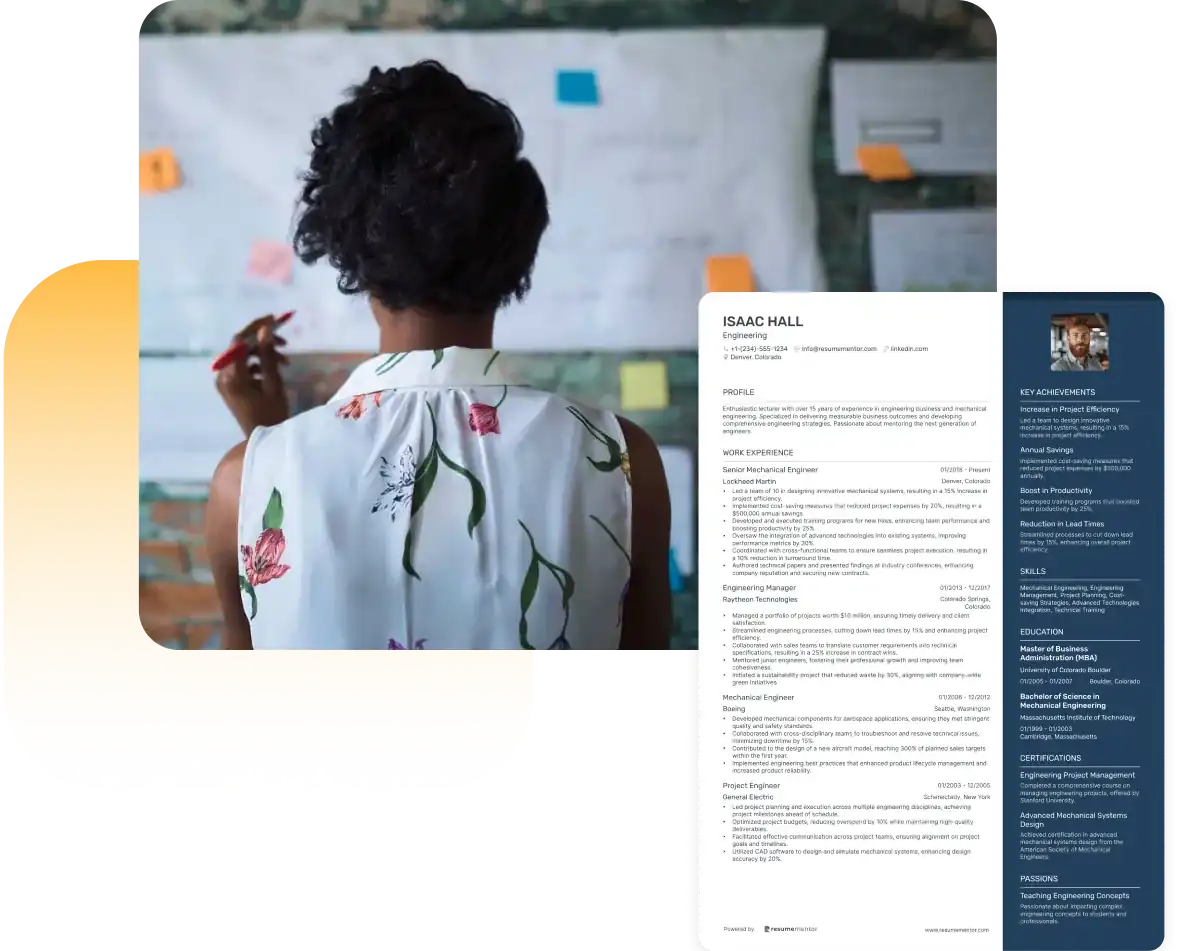
Continue Reading
Check more recommended readings to get the job of your dreams.
Resume
Resources
Tools
© 2025. All rights reserved.
Made with love by people who care.

